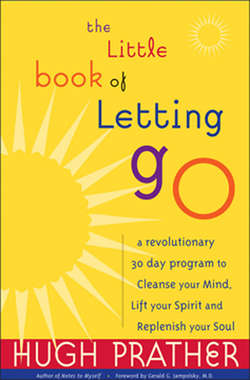Читать книгу The Little Book of Letting Go - Hugh Prather - Страница 15
На сайте Литреса книга снята с продажи.
Letting Go of Problems
ОглавлениеIt has taken longer to describe the process of letting go than it sometimes takes to do it. In real time, it can be more like: “I don't have to feel this way. Here's how I want to feel.” And then the weenies are cooked in peace. (Which is what eventually happened.)
You don't have to “feel this way,” because these are your feelings. One quick, honest look at them is occasionally all that's needed to remind you of that place where you can gently lay your conflicts and concerns. Usually a great deal more is needed—hence this book. We have gotten so caught up in our feelings of righteousness, put-upon-ness, irritation, cynicism, and the like that we have forgotten we can even feel another way. As a people we have come very close to entirely losing our belief in love that lasts, commitment that doesn't waver, and peace that cannot be disrupted.
At first, letting go can appear to be a daunting if not hopeless task. Our life and world are littered with endless problems, all of which we think we would dearly love to let go of, yet seldom is even one difficulty released completely. Everyone, it seems, moves from one problem to the next with no real season of rest. Even in the course of a single day, “it's just one thing after another.”
So central are difficulties to the meaning of people's lives that we usually define the individuals around us by their problems. Notice this the next time you hear someone who isn't present being discussed. Whether positively or negatively, their problems are being highlighted. This is true of our own self-definition as well. We tend to think of our identity, and even the overall meaning of our life, in terms of the difficulties we encounter.
We also believe we can gauge how severe other people's problems truly are, yet what might be a minor problem to one person can preoccupy another. There are two neighborhood cats, born and raised in the wild, who have adopted us. They love us so much that they bring us a portion of every bird, rat, and lizard they kill. Cleaning up these gifts is not a problem for me, but when I am out of town, it's a problem for the rest of my family. On the other hand, I would have to concentrate very hard to exchange e-mail with certain people in peace. Yet Gayle handles this task in stride.
It isn't that some people have a truly difficult life while others get off scot-free. We have all seen individuals go through shocking tragedies in relative peace, and we have seen ourselves and others eaten up by the daily grind. Enough happens in the course of a normal day—that is, there is enough raw material for the mind to work on—for any of us to justify being unhappy.
Problems assault us to the degree they preoccupy us. The key to release, rest, and inner freedom is not the elimination of all external difficulties. It is letting go of our pattern of reactions to those difficulties.
During the past twenty-five years of family counseling, Gayle and I have found ourselves continuously in awe of the basic happiness of most small children who live in abusive homes. It usually takes years of physical or emotional trauma before this fundamental state is finally destroyed. Live television reports from war zones, refugee camps, and areas of famine often capture the capacity of children to play and be happy in circumstances of unthinkable horror. However, to see the difference between how adults and children approach life, it isn't necessary to look further than a party.
